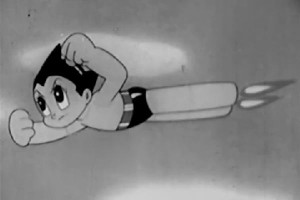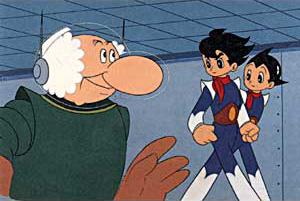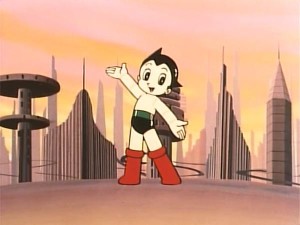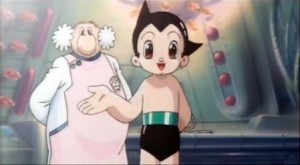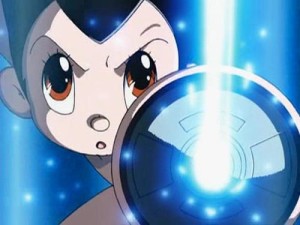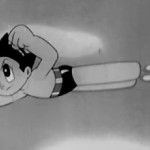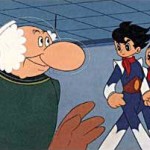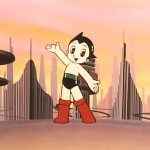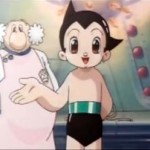Astro Boy [aka Mighty Atom] (Anime)
Also known as 鉄腕アトム (Tetsuwan Atomu)
Astro Boy, Tezuka’s well-known manga about a boy-robot has also been featured in three separate animated television series. Beginning with the 1963-66 Black & White series, which is often referred to as Japan’s first continuing animated television series, Astro Boy has also been the star of a 1980-81 full-colour series, as well as a 2003-04 computer special-effects remake. There has also been a theatrical release and a couple of animated shorts.
What it’s about
In the “near future”, the robot known as “Astro Boy” is the created by the genius roboticist Dr. Tenma after his young son Tobio is killed in an accident involving his robotic car. Dr. Tenma, then head of the Japanese Ministry of Science, is determined to recreate Tobio, and marshals all the considerable resources at his disposal to create the world’s most advanced robot – one capable of thinking and feeling like a human.
At first the project seems like a success, and Astro Boy lives peacefully with Dr. Tenma. However, it soon becomes apparent that Astro cannot simply replace Tobio. Enraged by the robot’s limitations to imitate a human child, Dr. Tenma abandons Astro Boy to a fate as a slave performing in a robot circus. Abused by the harsh ringmaster, who has no idea that he has acquired the world’s most sophisticated robot, Astro is eventually rescued by the kindly Dr. Ochanomizu. The new Minister of Science, replacing Dr. Tenma after he becomes wanted by the police for abusing his power and creating Astro, Dr. Ochanomizu rebuilds and restores Astro Boy.
Acting as a surrogate father figure, Dr. Ochanomizu teaches Astro to love and respect both human beings and robots, and he becomes somewhat of an ambassador between the two. However, the fugitive Dr. Tenma continues to consider Astro Boy to be his property, and believes that the robots will inevitably rise up against humanity, with Astro Boy as their leader.
What you should know
Shortly after taking his first tentative steps into the world of animation with the experimental film, Tales of a Street Corner (1962), Tezuka realized he needed a marketable product if he was going to sustain his newly-created animations studio, Mushi Productions, as a business. However, given it’s small size, Mushi Productions would not be able to produce animated features of the same quality of Walt Disney or Toei Animation, so Tezuka decided to focus on something that had never been tried in Japan – a weekly television anime series. Of course he needed to start with a bang, so his popular tale of a boy-robot, quickly went into production and the original Black & White Astro Boy (1963-66) animated television series was born.
Interestingly, Tezuka decided to produce Astro Boy (1963-66) as a loss-leader on a shoestring budget instead of trying to negotiate a more lucrative deal with a potential sponsor. Tezuka was very conscious of the fact that he was trailblazing the way for the Japanese television animation industry, and as such was adamant that production costs needed to be aligned with other live-action television programs if it was to be sustainable. However, this meant that Tezuka and his team had to develop three key techniques and strategies.
Tezuka’s first strategy was to rely heavily on high-quality story concepts (luckily something he had in spades). He understood that a good story can save poor animation, where good animation cannot save a poor story. The second was to use a form of limited animation – animating only what was absolutely necessary. Whereas animation for feature films used between 24 and 29 frames of animation per second to give it a smooth unbroken flow, Mushi Productions were forced to use as few as 10 frames per second on occasion. To compensate for this Tezuka stressed an economy of motion. Done well, this can be used to demonstrate both a subtlety of emotion (a tightening of an eye or lip for example) as well as frantic action. The third was construct action sequences in a multi-functional way and to file away every animation cell produced in a large image bank. In this way, Mushi Productions could re-use already completed animation in new ways, thereby allowing more new animated cells to be created each episode. As the stock-image bank grew, so did an increase in the overall quality of the final product.
On January 1, 1963, Astro Boy (1963-66) hit the airwaves on the Fuji TV network and was an instant hit, capturing nearly 40% of the audience. It also touched off a wave of licensed (as well as unlicensed) children’s toys and other associated products – with the benefits of commercialization invested back into the show to offset the production costs. Astro Boy (1963-66) was so successful that when a buyer for the American giant, National Broadcasting Company (NBC), who was traveling in Japan at the time, saw it, he was convinced that it must have been produced by an American company. Surprised to learn it was being produced in Japan, he contacted Mushi Productions and Tezuka was soon on his way to the United States of America – his first trip abroad. He signed a deal with NBC in New York, and Astro Boy hit the American airwaves in September 1963.
The popularity of the show was such that, in 1964, a theatrical release, Astro Boy: Hero of Space (1964) was cobbled together from three of the episodes: “The Robot Spaceship”, “Last Day on Earth”, and “Earth Defense Squadron” – the last two of which were filmed in full-colour.
However, all good things eventually come to an end, and the final episode of the original Astro Boy (1963-66) B&W anime series was broadcast on December 31, 1966. In the end, the series clocked in at 193 episodes – 104 of which were broadcast in the United States.
In 1977 Tezuka, deciding to return to animation, took a job as a director at the Toei Animation studio. He originally proposed a series called Mighty Mars as a remake and/or sequel to Astro Boy (1963-66). Toei Animation liked the idea and saw it as a series commemorating Tezuka’s 30th anniversary in the business (beginning with his 1947 manga, New Treasure Island). However, since Mushi Productions had declared bankruptcy in 1973 and the rights of Astro Boy (1963-66) went to their sponsor company, Meiji Seika Kaisha, Ltd. an official remake could not be made under these circumstances.
So, despite his work on the similar animated television series Jetter Mars (1977), It wasn’t until 1980, after Tezuka had finally regained the rights to many of his earlier works, that he could revisit Astro Boy properly. With its debut broadcast on October 1, 1980, the new Astro Boy (1980-81) animated television show – this time in full-colour – hit the airwaves on the Nippon Television network. Although the series tread over much of the same ground as the original manga series and the previous Astro Boy (1963-66) series, Tezuka never missed an opportunity to tinker with his creations – in the process creating a whole new generation of fans. One of the chief differences between the two series (aside from the obvious increase in quality of animation) is the ongoing sub-plot featuring Astro Boy‘s “brother”, Atlas. All told, Astro Boy (1980-81) lasted 52 episodes, and came to a close on December 23, 1981.
With Tezuka’s passing on February 9, 1989, that might have been the end of Astro Boy, but his importance in modern Japanese culture cannot be overstated. In 2001, the Osamu Tezuka Animation Theater in Kyoto began airing two new animated shorts – Astro Boy: New Edition (2001) and Astro Boy: Last Day of the Earth (2001).
However, this was just the beginning. April 7, 2003, the date specified in the original 1952 story as the day of Astro Boy’s creation, was celebrated with parades and festivals across the nation. Both Astro Boy and his creator Dr. Ochanomizu were issued birth certificates and legally registered as Japanese citizens by the government, and a new, animated television show featuring computer special effects began airing as part of the celebrations. Astro Boy (2003-04) series ran from April 7, 2003 to March 28, 2004, with a final count of 50 episodes.

